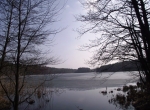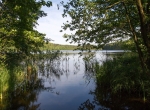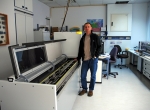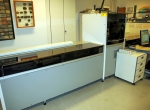Scanning of sediment cores from Lake Byszyno and Lake Rybackie
The sediment cores sampled from Lake Byszyno and Lake Rybackie were analysed at the University of Bremen with an XRF core scanner for the content of individual chemical elements present in the sediments.
The method of X-ray fluorescence (XRF) has many advantages and is widely used for studying lake sediment cores. The method is non-destructive which means that samples are tested without physical contact with the measuring detector and thus are not altered by the analysis. The sediment core can be examined without sub-sampling and spatial resolution of analysis is very high (less than 1 mm), which is impossible with traditional sampling methods and analysis of individual samples.
The XRF scanning of the sediments from Lake Byszyno and Lake Rybackie will help in determining the rate and character of environmental change occurring during the Migration Period in the catchment of the investigated lakes.
High-resolution XRF scanning of sediment cores from Lake Byszyno and Lake Rybackie
The material
Sediment core samples obtained from lakes Byszyno and Rybackie were split lengthwise and divided into two halves. One half of the core was analysed with an X-ray (XRF) core scanner. The core sample from Lake Rybackie was obtained as a single 200 cm long section with the length of the sediment profile of 190.5 cm. For Lake Byszyno it was necessary to correlate two separate sediment cores. The first core was obtained as a single section (L. 210 cm), with the length of the sediment profile of 204.5 cm. This core did not reach down to the base of the lake sediments and was correlated with a section of a core obtained with a piston corer by dr Michał Woszczyk, Adam Mickiewcz University in Poznań. Characteristic changes in the chemical composition of the sediment were used for the correlation, helping to obtain a complete sediment profile from Lake Byszyno with a length of 278.5 cm.
The measurement method
The sediment cores were scanned at the GEOPOLAR laboratory of the University of Bremen. XRF scanning is a non-destructive technique useful for determining the elemental composition of the tested material. The results are given in the form of the number of counts registered by the XRF detector. For the sediment core samples from the two investigated lakes the measurement was made with a Molybdenum tube, with the measurement time of 10 seconds and a sampling resolution of 5 mm. The raw data obtained from the analysis was recalculated using calibration curves and exported to *.xls format supported by MS Excel.
The measurement data
All the data about the chemical element content is presented as the number of counts (cnts) registered by the detector during a measurement time (10 seconds).
Literature:
Croudace IW, Rindby A, Rothwell G (2006) ITRAX: description and evaluation of a new multi-function X-ray core scanner. In: Rothwell RG (ed) New Techniques in Sediment Core Analysis. The Geological Society of London, Special Publications, London, pp. 51-63.
Author: Dr hab. Wojciech Tylmann
Department of Geomorphology and Quaternary Geology
Faculty of Oceanography and Geography
University of Gdańsk
Bażyńskiego 4, 80-952 Gdańsk
-
 full resolution
full resolution
Photo 1. Byszyno Lake
-
 full resolution
full resolution
Photo 2. Rybackie Lake
-
 full resolution
full resolution
Photo 3. Prof. dr hab. Wojciech Tylmann - author of analysis
-
 full resolution
full resolution
Photo 4. Laboratory


